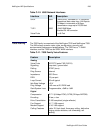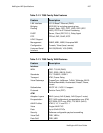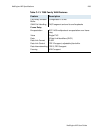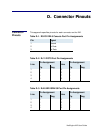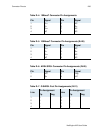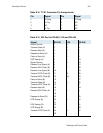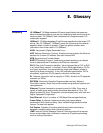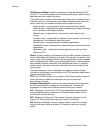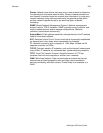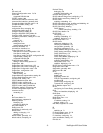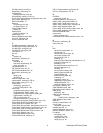
NetEngine IAD User Guide
Glossary 294
IGMP. Internet Group Management Protocol. Transport layer multicasting
protocol used by IP hosts to register their dynamic multicast group
membership. It is also used by connected routers to discover these group
members.
Inverse ARP. Inverse Address Resolution Protocol. Enables routers to
obtain the IP address of a known Ethernet address of a device associated
with a virtual circuit. Method of building dynamic routes in a network.
IP. Internet Protocol. Part of the TCP/IP protocol. IP networks are
connectionless, packet switching networks.
IP address. 32-bit address assigned to hosts using TCP/IP. An IP address
contains four octets separated by periods, also known as a dotted quad
address. Each address consists of a network number, an optional sub-
network number and a host number. The network and sub-network
numbers together are used for routing, while the host number is used to
address an individual host within the network or sub-network.
IP SNAP. Sub-network Access Protocol. Internet protocol that operates
between a network entity in the sub-network and a network entity in the
end system. SNAP specifies a standard method of encapsulating IP
datagrams and ARP messages on IEEE networks. The SNAP entity in the
end system makes use of the services of the sub-network and performs
three essential functions: data transfer, connection management and QOS
selection.
LAN. Local Area Network. Privately owned network-connecting devices
over a limited geographic area—usually limited to an office or office
complex. Often connected to the Internet via IADs, with firewall software to
limit access to the LAN by authorized users. May use TCP/IP or one of
several other protocols.
LMI. Local Management Interface. A set of the following enhancements to
the basic Frame Relay specification. Called LMT in ANSI terminology.
a keep-alive mechanism that verifies that data is flowing.
a multi-cast mechanism, which provides the network server with its
local DLCI and the multi-cast DLCI.
Global addressing; this gives DLCIs global rather than local
significance in Frame Relay networks.
a mechanism that provides an on-going status report on the DLCIs
known to the switch.
MAC. Media Access Control. Lower of the two sub-layers of the data link
layer defined by the IEEE.
MAC address. Standardized data link layer address that is required for
every port or device that connects to a LAN. Other devices in the network
use these addresses to locate specific ports in the network and to create
and update routing tables and data structures. MAC addresses are six
bytes long and are IEEE-controlled. Also known as a hardware address, a
MAC-layer address, or a physical address.
MPEG. Moving Pictures Expert Group.
Notified Entry. IP address of the MGCP Call Agent; controls the call setup
and teardown for all call features under MGCP.



